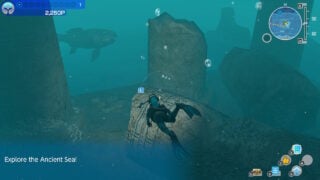Endless Ocean Luminous is a one-trick seahorse, but a pleasant one
Fans of the previous games may be disappointed at the changes made, however
- Director and lead designer
- Akito Kitamura
- Key Credits
- Hitoshi Hirashima (Lead program director), Jun Hosoba (Lead art director)

Japanese developer Arika has enjoyed a close relationship with Nintendo over the years.
Originally founded in the ‘90s by former Capcom employees, the studio teamed up with Nintendo in the early Wii days for Endless Ocean, with Arika developing and Nintendo publishing.
The game’s success led to a partnership which continues to this day, resulting in a second Endless Ocean game on Wii, four download-only Dr Mario sequels, and the 3D Classics range of NES 3D remasters on the 3DS.
In recent years Arika was the studio behind Switch Online titles Tetris 99, Pac-Man 99 and the superb Super Mario Bros 35, but now it’s gone back to where its relationship with Nintendo started. Endless Ocean is back for a third game, but sadly, this time it’s lost some of its magic.
As in the previous two games, the general vibe of Endless Ocean Luminous is one of swimming around large bodies of water, exploring your surroundings while encountering a wide variety of underwater creatures.
Whereas the two Wii titles featured predesigned locations, however, Luminous instead focuses mainly on procedurally generated areas. The game’s main two single-player modes are Story and Solo Dives, and the latter is clearly the main focus by some distance (and it can also be played online with up to 30 players).
https://www.youtube.com/watch?v=xKd4xzBYzHE
Choosing a Solo Dive puts you in a large body of water, and gives you an empty 10×10 grid for a map. Each of these 100 squares contains a smaller 5×5 area (meaning there are 2,500 squares in total), and as you swim over each of these small squares they’re filled in.
The aim, then, is to move around and explore the area to fill in the smaller squares and slowly reveal more of the map. Once 80% (2000) of the squares are filled, the rest of the map is automatically completed and you’re given an image showing that area’s ‘Dive-Site ID’, meaning other players can enter it to play the same map you did.
Although each dive site is procedurally generated, there are still some notable features that appear to be pre-built and randomly appear from time to time. We’ve stumbled on the same sunken ship a couple of times and some of the ancient ruins we’ve discovered have appeared again in subsequent dives. That said, each area is large enough that they each still feel distinct, and you’ll still end up finding dives that you favour over others.
Naturally, each body of water is also inhabited by a wide variety of aquatic creatures, and the areas are large enough to feature distinct biomes with different species in each. The bluer, warmer areas are more likely to generate schools of tropical fish, sea turtles and hammerhead sharks, while the caves and deeper, darker areas are where you’re more likely to find odder, less aesthetically pleasing beasts.
Marine a-fish-ionados will doubtless turn their noses up at the mixing of species, and there are plenty of situations where fish that are usually located at opposite parts of the world or in completely different climates will be found happily swimming side-by-side here, but despite the reams of information available here (mostly by scanning fish and getting biographies on them), this is still a game at least partially grounded in fantasy.
The Veiled Sea – which is the general name for all combined bodies of water in the game – contains some rare fictional species, which can usually be found in Solo Dive by tracking down a set number of specific fish with unusual biometric patterns. Once they’re all found, you’ll be given the location of a UML (the underwater equivalent of a UFO), which is one of these rare, mythical beasts, where you can then scan it and take a photo of it.
This is the main progression mechanic in the game, incidentally. There are more than 570 species in the game, from the tiniest 4cm clownfish to the rarest 20-metre prehistoric and fictional beasts. By holding the L button as you approach them you can scan them, which reveals their species name and a short 60-70 word description of them.
“There are more than 570 species in the game, from the tiniest 4cm clownfish to the rarest 20-metre prehistoric and fictional beasts.”
You can also hit ZL to bring up a camera, switching to a viewfinder mode where you can try to take a good photo of them. Each time you scan or photograph a new species it’s added to your Creature Log, so anyone striving for 100% completion will want to fill their album.
Even though you get unlimited attempts at taking a photo, there’s still a sense of satisfaction when you manage to zoom into a particularly speedy species, line up a perfect shot and capture it in that split-second where it fills the frame.
Solo Dives, then, can take up a decent amount of your time, as you explore each map, scan and snap as many species as you can find in that particular environment, then start all over again with a new one. It’s probably just as well, because the Story mode is awful.
Its 14 missions tell the story of the World Coral, a large tree-like structure underwater which provides life to the sea in some sort of way that too much extra detail would spoil. Your diver is accompanied by a talking AI (who has voice acting), and a second diver (who doesn’t, and is instead ‘voiced’ by silly masked burbling and gurgling despite having far fewer lines than the AI).

Each mission is very short at best – tasking you with scanning a couple of fish or taking a handful of photos – and completely non-interactive at worst, as some of them are simply cutscenes and nothing else.
To make matters worse, unlocking each mission in Story involves scanning a large number of fish, which can only realistically be done in Solo Dive. This means Story mode generally involves playing an extremely short ‘mission’, then going into Solo Dive and scanning another 500 to 1,200 fish, then going back to Story and doing the next mission (or cutscene).
As a final insult, the last couple of missions can only be unlocked by completing the Mystery Board, a sort of achievement system with 99 separate ‘Mysteries’ you have to clear. The problem is, these mostly involve finding certain items, areas or species in Solo Dive, and locked Mysteries give absolutely no clue as to what you’re looking for.
As such, after 15 hours of play we had only collected 33 of the 99 Mysteries, with no clue how to get the other 66 other than continually playing Solo Dive and scanning everything we could.
In short, if you enjoyed the stories in the first two Endless Oceans and you’re specifically planning to buy Luminous for the Story mode, you really shouldn’t bother. Solo Dives (and their 30-player online equivalent Shared Dives) are the main draw here.
“In short, if you enjoyed the stories in the first two Endless Oceans and you’re specifically planning to buy Luminous for the Story mode, you really shouldn’t bother.”
That’s not to say Solo Dives aren’t without issue, either. There’s zero opportunity to interact with the fish you encounter in this game, for a start.
Even though the second game Endless Ocean 2: Adventures of the Deep (or Blue World, as it was known in America) let you feed and pet certain species, or use tools to heal or calm others, there’s nothing of the sort here, you just bump into them or sometimes even pass through them.
There’s also no threat. The second game also introduced the ability for some species to harm you, but that too is completely gone, meaning you can swim right up to a great white shark and perform a taunt in front of his massive mouth and he’ll just stare through you as if you weren’t there.

We understand that some players will prefer this because the danger element sort of goes against the calm vibe of the game, but the option to turn it on would have made exploring Solo Dives more exciting.
Imagine entering a cave and finding a big prehistoric crocodile thing which spots you and charges at you, instead of blithely ignoring you like they do in the game.
Above all, there’s no shaking the fact that at times this feels more like an HD remaster of the Wii games than a truly current-gen title. Some of the environments are rather low-poly in nature, the fish move in a slightly robotic manner and if you take a photo of one when it swims next to a rock or something similar, the texture quality of the background object is distractingly blurry.
Given the age and capabilities of the Switch hardware it would of course be foolish to expect richly detailed environments with ray-traced lighting splitting through the surface, but some suspension of disbelief is still needed to truly appreciate Endless Ocean Luminous.
Other than the obvious jump in resolution, there’s not a lot here to make Luminous feel streets ahead of its predecessors in terms of atmosphere or detail.

Fans of the previous Wii titles, then, may feel a little disappointed by Luminous given that it’s quite dissimilar to what came before it. The switch from preset areas to procedural generation leads to a different experience when exploring, and the woefully inept Story mode is a huge let-down.
Taken on its own merits, though, Luminous does still provide enjoyment in its Solo Dive mode, as long as players are happy enough with exploring random environments, uncovering maps, swimming through the various nooks and crannies thrown up by its algorithms and scanning and photographing the species they come across.
It’s not the same Endless Ocean that fans will be familiar with, but it’s a pleasant enough experience in its own unique way.
A copy of Endless Ocean Luminous was provided for review by Nintendo.
Endless Ocean's procedural generation keeps its exploration engaging enough for a while, but its Story mode is poor. As long as you're willing to forgo plot (and any meaningful interaction with the species you encounter) in favour of exploring random underwater environments, there's still a good deal of fun to be had here.
- Exploring procedurally generated environments is fun
- Wide variety of species to scan and log
- Taking perfectly timed photos is oddly satisfying
- Story mode is dull with ridiculous unlock requirements
- Lack of creature interactions feels a bit empty
- Looks pretty rough at times






















